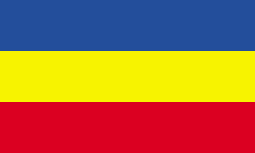
Mecklenburg is a historical region in northern Germany comprising the western and larger part of the federal-state Mecklenburg-Western Pomerania. The largest cities of the region are Rostock, Schwerin, Neubrandenburg, Wismar and Güstrow.
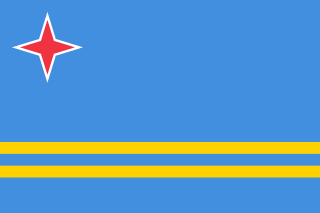
The national flag of Aruba was adopted on 18 March 1976, along with the official anthem "Aruba Dushi Tera". The flag was partially designed by vexillologist Whitney Smith. On 18 March Aruba celebrates National Anthem and Flag Day, marked by local events across the island. It is also a significant day as it represents the acceptance by the Kingdom of the Netherlands of Aruba's right to an autonomous status.

The national flag of Poland consists of two horizontal stripes of equal width, the upper one white and the lower one red. The two colours are defined in the Polish constitution as the national colours. A variant of the flag with the national coat of arms in the middle of the white fess is legally reserved for official use abroad and at sea. A similar flag with the addition of a white eagle is used as the naval ensign of Poland.

The national flag of Lithuania consists of a horizontal tricolour of yellow, green, and red. It was adopted on 25 April 1918 during Lithuania's first period of independence from 1918 to 1940, which ceased with the occupation first by the Soviet Union, and then by Nazi Germany (1941–1944). During the post-World War II Soviet occupation, from 1945 until 1989, the Soviet Lithuanian flag consisted first of a generic red Soviet flag with the name of the republic, then changed to the red flag with white and green bands at the bottom.

Dreschvitz is a municipality in southwest Vorpommern-Rügen, a district on the island of Rügen in Mecklenburg-Vorpommern, Germany. It is managed from the Amt of West-Rügen with its head offices in the village of Samtens.
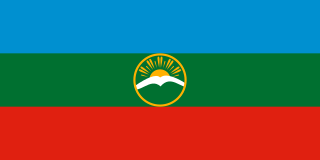
The flag of Karachay–Cherkessia, a federal subject and republic in the Russian Federation, was adopted on 26 July 1996.

The civil flag that serves as the symbol of the state of Mecklenburg-Vorpommern, Germany, consists of five horizontal stripes, that are from the top to bottom: blue (ultramarine), white, yellow, white, and red (vermilion). It was designed by Norbert Buske and adopted on 29 January 1991. It is a combination of the historical flags of the Mecklenburg and Western Pomerania.

The flag that serves as the symbol of the historical and geographical regions of the Silesia, and Lower Silesia, and as one of the symbols of the Silesian people, is divided horizontally into two stripes: white on the top and yellow on the bottom. It originated as the flag of the Province of Silesia, used from 1882 to 1919, that later used as the flag of the Province of Lower Silesia, from 1920 to 1935. Currently, the flag is recognized symbol of the Silesian people in the state of Saxony in Germany.
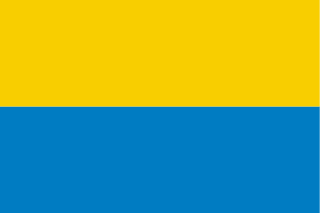
The flag that serves as the symbol of the historical and geographical region of the Upper Silesia, and as one of the symbols of the Silesian people, is divided horizontally into two stripes: yellow on the top and blue on the bottom. It originated as the flag of the Province of Upper Silesia adopted in 1920, with its colours based on the coat of arms of Upper Silesia. The flag is also popular symbol used by the Silesian Autonomy Movement.

The flag of the Podlaskie Voivodeship, Poland is a rectangle divided into four horizontal stripes, that are, from the top to bottom: white, red, yellow, and blue. It was designed by Tadeusz Gajl, and adopted on 30 August 2002.

The civil flag of the Silesian Voivodeship, Poland is triband rectangle, divided into three horizontal stripes, that are from top to bottom: blue, yellow, and blue. The blue stripes are twice the size of the yellow middle stripe. The state flag is a blue rectangle with yellow eagle placed in its centre. It was designed by Barbara Widłak, and adopted on 11 June 2001.

The flag of the West Pomeranian Voivodeship, Poland is a triband rectangle, divided vertically in 3 stripes of white, red, and white colour, and with the coat of arms of the voivodeship in the middle. It was adopted in 2000.
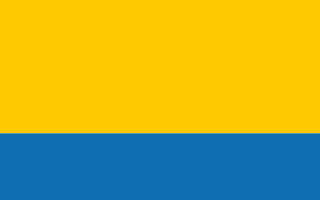
The civil flag of the Opole Voivodeship, Poland is a rectangle divided into two horizontal stripes, with yellow on the top, and blue at the bottom. The top stripe is twice the size of the bottom one.
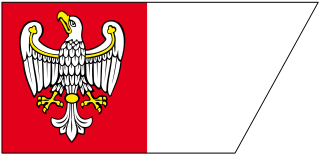
The flag of the Greater Poland Voivodeship, Poland is a trapezoid divided into red stripe on the right, and white stripe on the left, with a white eagle with yellow (golden) beak, legs, stripes on its wings, and a ring on its tail, featured in the middle of the red stripe. It was adopted in 2000.

The flag of the Warmian–Masurian Voivodeship, Poland is red with a white boundary on its top, bottom, and right sides, and with the head of a white (silver) eagle, with yellow (golden) beak, and an eye, wearing a yellow (golden) crown, located on its left side. It was adopted in 2002.

The flag of the Świętokrzyskie Voivodeship, Poland is a rectangle divided into four parts. Its left part features a yellow vertical stripe, which wight equals to 1:4 of the wight of the flag. Its right part is divided into three horizontal stripes, that are, from top to bottom: blue, white, and red. In the middle of the white stripe is placed the coat of arms of the voivodeship. The first version of the flag had been adopted in 2001, and current version is used since 2013.

The flag that serves as the symbol of the historical and geographical region of the Western Pomerania is divided horizontally into two stripes: light blue on the top and white on the bottom. It originated as the flag of the Province of Pomerania, Prussia, used from 1882 to 1935. Since 1996, it is officially recognized as the symbol of the historical region of Western Pomerania within Mecklenburg–Western Pomerania, Germany.

The coat of arms of Pomerania, also known as the Pomeranian Griffin, is the symbol of Pomerania, a historical region on the southern shore of the Baltic Sea in Central Europe, split between Poland and Germany. It depicts a red griffin with yellow (golden) beak and claws, placed within a white (silver) shield. It originates from the late 12th century.
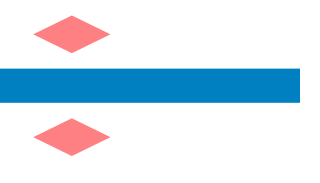
The flag, which serves as the symbol of the city of Białogard, West Pomeranian Voivodeship, in western Poland, is divided into three horizontal stripes, including a blue stripe in the middle, and two white stripes, twice its size, placed on top and bottom, and with two light red rhombuses, each placed in the left corner of white stripe. The flag was established in 2004.
